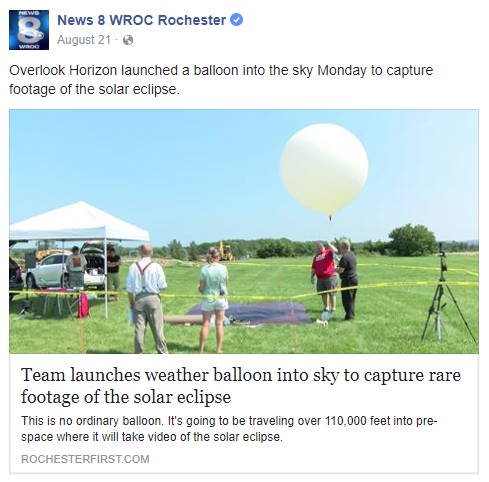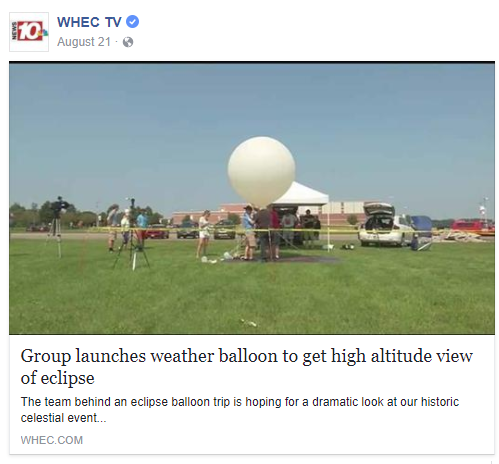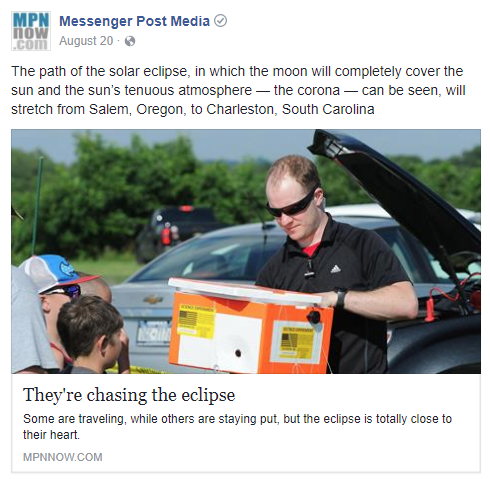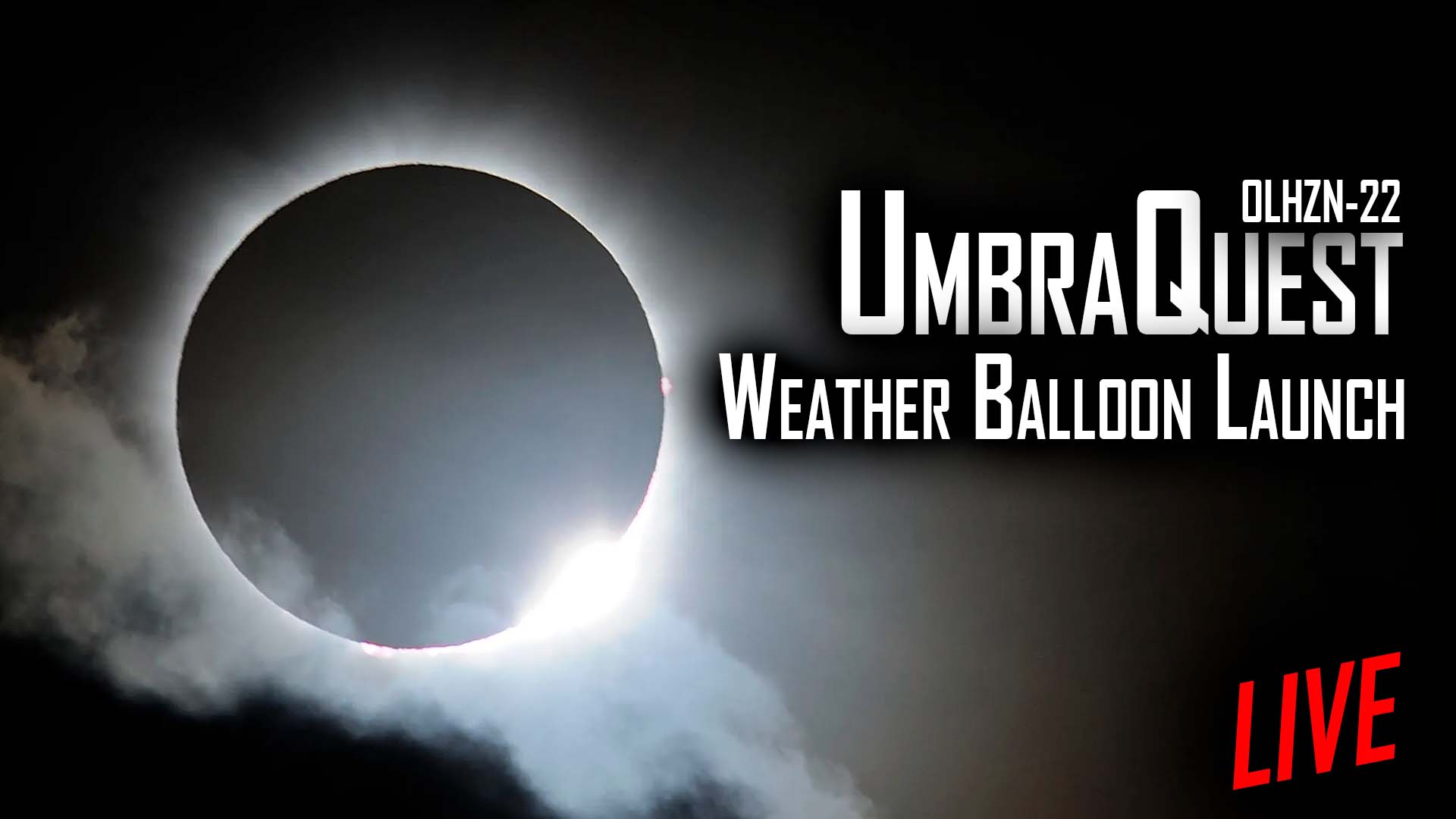CANANDAIGUA NY – 03 APRIL 2024 – Overlook Horizon Inc., a leading organization in atmospheric research and educational outreach, is excited to announce the launch of its latest high altitude weather balloon mission, OLHZN-22 “UmbraQuest”. Scheduled for Monday, April 8, 2024, this mission is set to coincide with the rare astronomical event of a total solar eclipse.
“UmbraQuest” aims to capture breathtaking video footage and conduct atmospheric measurements during the eclipse, providing invaluable data to both the scientific community and the public. This follows the success of our previous mission, OLHZN-9, which captured stunning imagery of a partial solar eclipse in 2017. However, this year’s total eclipse offers a unique opportunity to observe and record the celestial phenomenon like never before.
The launch will take place in Canandaigua, NY with the balloon expected to reach its maximum altitude of around 105,000 FT. during the peak of the solar eclipse. Overlook Horizon invites local news, TV, and print media to cover this significant event. Coverage is welcome in the lead-up to the launch, on launch day, or in the aftermath, as we analyze the collected data and imagery.
“We’re thrilled to undertake this mission during such a pivotal moment,” said Tory Carissimo, Flight Director of Overlook Horizon. “Not only does it allow us to contribute valuable scientific data, but it also provides a unique lens through which the public can engage with and understand the importance of space and atmospheric research.”
Media representatives are invited to attend the launch and interview the team. Exclusive footage and interviews can be arranged upon request.
For more information about OLHZN-22 “UmbraQuest” and Overlook Horizon’s mission to promote science education through high-altitude balloons, visit our website at https://overlookhorizon.com/flight-22
About Overlook Horizon
Overlook Horizon High Altitude Balloons is a non-profit organization based in Canandaigua, NY, dedicated to inspiring and educating the public about science and technology through the exciting world of high-altitude balloons. Our missions explore the edge of space, capturing stunning visuals and gathering critical atmospheric data to advance scientific understanding.
Previous 2017 Eclipse Coverage




Safety and Compliance
Overlook Horizon is committed to conducting all its high-altitude balloon (HAB) flights with the utmost attention to safety and strict compliance with regulatory standards. We engage in proactive measures including:
- Regulatory Compliance: Even though small HAB flights have fewer regulations in the US, Overlook Horizon chooses to adhere to the stricter guidelines applicable to heavier flights. This commitment enhances safety and fosters positive relations with the aviation community and regulatory bodies.
- FAA Collaboration: Maintaining a strong relationship with the local FAA Flight Standards District Office (FSDO) ensures we stay informed about the latest regulatory changes and align our operations with aviation safety standards.
- NOTAMs Filing: For every flight, Notices to Airmen or Notice to Air Missions (NOTAMs) are filed with airspace authorities to inform air traffic of our operations, enhancing safety for all parties involved.
- Safety Gear: Our payloads are equipped with radar reflectors for visibility to radar systems and high-visibility strobe lights for operations during low light conditions. We implement safety measures to minimize risks, such as avoiding trailing antennas and limiting suspension system lengths.
Mission Overview
The OLHZN-22 “UmbraQuest” mission, scheduled for April 8, 2024, is set to embark on an unprecedented journey to the edge of space during one of the most awe-inspiring celestial events: a total solar eclipse. This mission is not just about capturing the eclipse from a vantage point few can imagine; it’s also about understanding the atmospheric effects such an event can have on our planet.
Objective:
“UmbraQuest” aims to capture a unique third-person perspective of the total solar eclipse and its shadow crossing the Earth’s surface. The mission seeks to record the temperature drop during the period of totality, providing data to estimate the change in solar energy impacting the Earth during this brief but significant event.
Equipment and Technology:
The mission is equipped with cutting-edge technology to ensure its success:
- Onboard Computers: Two onboard tracking computers will send periodic radio beacons back to ground receiving stations, ensuring the mission’s progress is monitored in real-time. These radio beacons can be publicly received and decoded by amateur radio operators up to 200 miles away.
- Sensors: The payload is outfitted with sensors to measure external temperature, pressure, humidity, and wind speed, offering a comprehensive view of the atmospheric conditions encountered during the flight.
- Cameras: Three cameras are onboard to document the journey. Two action cameras will record the entire flight in resolutions up to 4K, capturing the stunning visuals of the eclipse and its effects on the Earth below. A third camera, dedicated to live streaming, will transmit live imagery back to the ground station for as long as possible, providing real-time visuals of the eclipse from the stratosphere.
Challenges and Preparations:
Launching a mission during a total solar eclipse presents unique challenges, notably in terms of timing and recovery. The mission team has conducted extensive preparations, including flight profile predictions and safety measures, to mitigate risks and maximize the success of the mission. Despite limitations on timing and location due to the nature of the eclipse, the team is prepared to navigate these challenges with advanced planning and technology.
Significance:
The OLHZN-22 “UmbraQuest” mission represents a significant opportunity to contribute to our understanding of solar eclipses and their effects on the atmosphere. By combining direct observations with atmospheric data collection, Overlook Horizon aims to enrich both scientific knowledge and public understanding of these spectacular events.
Through this mission, Overlook Horizon continues its commitment to advancing atmospheric science and education, sharing the wonders of space and science with the world.
Data Sharing and Public Engagement
Following the mission, Overlook Horizon will make basic data available immediately, with more detailed findings and high-quality video footage to be shared upon successful payload recovery. These will be accessible:
- Website Publishing: Detailed mission data and videos will be published on OverlookHorizon.com
- YouTube Channel: Engaging video content, including mission footage, will be shared on our YouTube channel (https://youtube.com/OLHZN) to reach a broader audience.
Challenges and Solutions
Over the years, Overlook Horizon has faced and overcome numerous challenges:
- Transmitter Failures: Implementing backup transmitters has allowed us to maintain mission integrity even when primary systems fail.
- Difficult Recoveries: We’ve introduced remote cutdown systems to address payloads landing in inaccessible areas like tall trees or power lines, enhancing the recovery process. By increasing the reliability of our tracking systems, we can confidently use more advanced camera equipment, leading to even more stunning and captivating footage.
Notable Missions
https://overlookhorizon.com/flight-21
The partnership with the NHL’s Vegas Golden Knights for their 2019 season opener stands as our most popular mission, highlighting the unique and engaging nature of our work. This mission showcased our ability to blend sports, technology, and science in a captivating way.
Mission-Specific Challenges for OLHZN-22
The OLHZN-22 “UmbraQuest” mission faces unique challenges due to the timing and nature of the solar eclipse:
- Limited Control Over Timing and Location: The eclipse’s fixed schedule reduces flexibility in planning for optimal flight conditions and recovery locations.
- Recovery Challenges: Given the expected complexities of the day, including potential public and logistical issues, the team is prepared for a challenging recovery process.
OLHZN-22 Flight Path Prediction
This map shows the flight predictions and will update as the launch day approaches
Mission Timeline
| Hr/Min/Sec | Event |
| -01:30:00 | Tracking systems placed on ground power |
| -01:20:00 | Balloon inflation preparation begins |
| -00:55:00 | Balloon inflation begins |
| -00:40:00 | Balloon inflation complete & anchored |
| -00:30:00 | Backup tracking systems activated |
| -00:21:00 | Primary tracking systems moved to battery power |
| -00:17:00 | FAA notifications made to relevant agencies |
| -00:15:00 | Camera systems activated |
| -00:12:00 | Transmitter verifications completed |
| -00:10:00 | Payload closed & secured |
| -00:08:00 | Payload attached to balloon |
| -00:07:00 | Ground tracking systems initiated |
| -00:05:00 | Safety tether released |
| -00:03:00 | Balloon raised to release height |
| -00:00:00 | LIFTOFF |
| +00:02:00 | Partial solar eclipse begins |
| +00:05:00 | Radio reception verification |
| +01:16:00 | Solar eclipse totality begins |
| +01:19:30 | Solar eclipse totality ends |
| +01:50:00 | Estimated balloon burst & descent begins |
| +02:28:30 | Solar eclipse ends |
| +02:36:00 | Estimated payload landing |
| +02:40:00 | Chase teams depart for recovery |
| +03:45:00 | Chase teams arrive on site to begin the recovery hunt |

